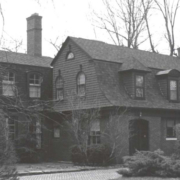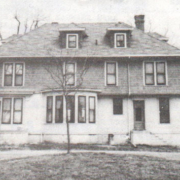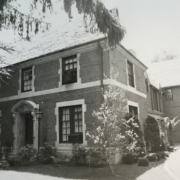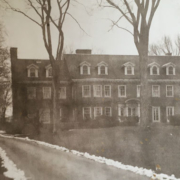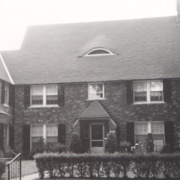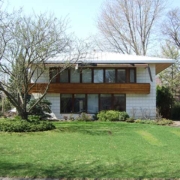Historical Architecture of Grosse Pointe – Welcome to 7 Woodland Place
Last week we presented the striking Federalist inspired home – 2 Woodland Place – by one of Grosse Pointes most prolific architects Robert O’Derrick.
This week we stay on Woodland Place, and explore another of the streets individualistic homes – 7 Woodland Place.
Originally designed by William Buck Stratton, 7 Woodland Place is arguably one of the more unique homes found in Grosse Pointe. It was completed in 1909 as a summer home of the Hazen S. Pingree family. Hazen S. Pingree was a four-term mayor of Detroit, a successful businessman, and the 24th Governor of the State of Michigan.
Pingree was a cobbler by trade. Having moved to Detroit in 1865 he established a successful shoe making company. By 1886, it was a 1 million dollar company with 700 employees turning out a half-million shoes and boots a year. It was the second biggest shoe manufacturer in the U.S. Source: Wikipedia.
In 1872 Pingree married Frances A. Gilbert and together they had three children. Hazen S. Pingree died in 1901, and so the summer home commissioned on Woodland Place was created for his wife and children.
It was the first house to be built on this once heavily wooded area. Mrs. Pingree hired one of Detroit’s most prominent architects, at the time, William Stratton, to design her new summer residence.
Stratton was an innovative designer, and has often been described as having a vigorous creative imagination with a diverse range and aptitude for switching between architectural styles. He was constantly at the forefront of the latest trends in commercial and residential design, which allowed him to create buildings that were ahead of their time. He designed many homes in Grosse Pointe, where his approach ranged from the formal to the informal, the traditional to the free flowing. Stratton was also known for his skill at adapting his style to the desires of his client, while stretching the brief as much as possible. You can read his full story by clicking here.
His design for 7 Woodland Place centered on the Dutch Colonial style, complete with gambrel rood and flared eaves – it is not clear how big the original home was.

7 Woodland Place – Courtesy of Grosse Pointe Historical Society.
In 1935 the Pingree family hired renowned Michigan architect Hugh T. Keyes to make extensive additions to the house to convert it from a summer home to a year-round residence. Keyes had a stellar reputation for making significant alterations to existing homes, and had undertaken several such projects in Grosse Pointe.
Research suggests the changes, made by Keyes, tripled the size of 7 Woodland Place, transforming it to over 5,200 sq ft. The large foyer (17’ x 16’ sq ft), living room (23’ x 17’), music room (27’ x 16’) and the library (24’ x 16’) all have natural fireplaces. There are 7 bedrooms in total, two of which have their own sitting rooms, while a further two were used as maids quarters. The interior features superb architectural details, including herringbone hardwood floors, 10ft ceilings, wood paneling, an elaborate semi-circular music room, and an elevator.
Research on Wikipedia states that Keyes retained the same brick construction and created a bow-fronted wing that wrapped around part of the original structure. The research also explains how Keyes added a mansard roof, and blended it with the original gambrel roof. Source: Wikipedia.

The addition of a new roofline significantly altered the appearance of the home, and in essence changed its original architectural style from Dutch Colonial to more of a French style. Mansard roofs were extremely popular in 19th Century France. It is a style that proved to be extremely popular in the Grosse Pointe communities during this era, and was a dominant architectural feature of many designs.
The changes Keyes made to 7 Woodland Place are also believed to mark the beginning of Keyes’s French-influenced Regency style. It is believed Keyes regarded his work at 7 Woodland Place as one of his greatest designs. Source: Wikipedia.
Descendants of the Pingree family lived in the home until 1976.
Keyes went on to design several more homes in Grosse Pointe, including a significant alteration to 2 Woodland Place. His work crossed many significant periods of architectural styles during his long career, which came to an end in the 1950’s.
7 Woodland Place is currently for sale – Please click here to view full details or call us to schedule a tour.
Written by Katie Doelle
Copyright © 2017 Katie Doelle

